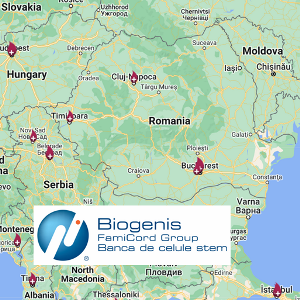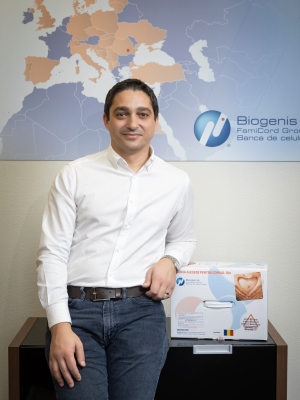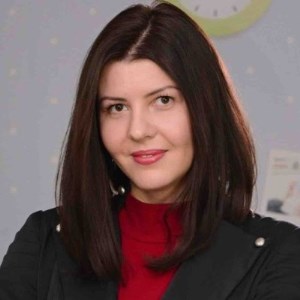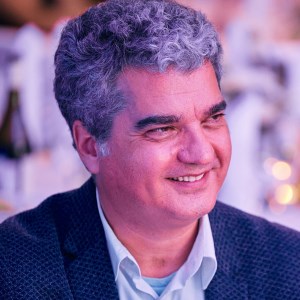Jesteś tutaj
Cord Blood Banking and Autism Therapy in Romania
 Romania is a country in southeastern Europe that has a waterfront on the Black Sea and land borders with the five countries Ukraine, Moldova, Hungary, Serbia, and Bulgaria1,2. To give Americans an idea of the size of the country, Romania is twice as big as the state of Pennsylvania. The southern border of Romania is defined by the Danube River. There are 19 million people living in Romania and the majority (about 83%) are ethnic Romanians that speak the Romanian language and follow the Romanian Eastern Orthodox Church. The two significant minority groups in Romania are Hungarians and the Roma community (formerly known as gypsies). The history of Romania is very complex, with cycle after cycle of battles between warring fiefdoms and empires. Romania is dotted with picturesque villages and medieval castles. Transylvania, a region in central Romania, is the home of the legendary Count Dracula, inspired by the historical person Vlad Dracula (1431-1476)3,4. After the end of WWII, many Romanians moved from villages to cities, which now hold a bit over half the population.
Romania is a country in southeastern Europe that has a waterfront on the Black Sea and land borders with the five countries Ukraine, Moldova, Hungary, Serbia, and Bulgaria1,2. To give Americans an idea of the size of the country, Romania is twice as big as the state of Pennsylvania. The southern border of Romania is defined by the Danube River. There are 19 million people living in Romania and the majority (about 83%) are ethnic Romanians that speak the Romanian language and follow the Romanian Eastern Orthodox Church. The two significant minority groups in Romania are Hungarians and the Roma community (formerly known as gypsies). The history of Romania is very complex, with cycle after cycle of battles between warring fiefdoms and empires. Romania is dotted with picturesque villages and medieval castles. Transylvania, a region in central Romania, is the home of the legendary Count Dracula, inspired by the historical person Vlad Dracula (1431-1476)3,4. After the end of WWII, many Romanians moved from villages to cities, which now hold a bit over half the population.
Romania today faces some economic and demographic challenges. Since the end of Communist rule in 1989, Romania has formed close ties with Western Europe, and became a member of both NATO (2004) and the EU (2007). While Romania was once considered one of the poorest countries in Europe, over the two decades since 2000 Romania has averaged GDP growth of 3.6% per year and has “made impressive gains in converging with Western Europe”5. At the same time, membership in the EU has enabled many people to leave Romania for opportunities elsewhere. As of 2018, it was estimated that about 20% of working-age people had left Romania, one of the largest emigrations out of a country in Eastern Europe3,5. Widespread emigration impacts the economy, the birthrate, and has split many families, especially in rural areas.
Recently, the shocks induced by the COVID-19 pandemic and the war in Ukraine have added strains to the economy of Romania. During the first half of 2022, the GDP grew by 5.7%, in part thanks to a 7.5% increase in private consumption as pandemic restrictions were gradually lifted. But the annual rate of inflation hit 16.37% by December 2022, in the context of the significant increase in utility costs for electricity and heating (up 41.4%).
Romania ranks among the 20 countries in the world with the lowest rate of births in 20216,7. The average mother’s age at first childbirth was 27.3 years old in Romania in 20226. There have been numerous media reports about the world-wide crash in fertility rates, and their “jaw-dropping” implications; almost all countries are facing aging societies, and many countries will lose half their population by the turn of the next century8. These issues are a serious concern in Romania. Many developed nations hope that emigration and the arrival of refugees will boost their population despite declining birthrates. In Romania, there is some potential for population growth from Ukrainian refugees. According to UNICEF, 2.4 million refugees crossed into Romania since the start of the war next door. Most of these refugees continued on their journey, but around 100,000 Ukrainian refugees are currently staying in Romania9.
 Surprisingly, given Romania’s low birthrate, Romania is one of the most active markets in Europe for cord blood banking. There are ten different private cord blood banks participating in the market, and the two main birthing hospitals in Romania offer their own cord blood banking services. Romania does not have a public banking system to store cord blood donations. The percentage of new mothers that bank their baby’s cord blood is estimated to be 7% in Romania, second in Europe only to Portugal at 10%. By comparison, in many countries that are famous for their medical technology, such as the United States, the penetration of cord blood banking is less than 3% of births10.
Surprisingly, given Romania’s low birthrate, Romania is one of the most active markets in Europe for cord blood banking. There are ten different private cord blood banks participating in the market, and the two main birthing hospitals in Romania offer their own cord blood banking services. Romania does not have a public banking system to store cord blood donations. The percentage of new mothers that bank their baby’s cord blood is estimated to be 7% in Romania, second in Europe only to Portugal at 10%. By comparison, in many countries that are famous for their medical technology, such as the United States, the penetration of cord blood banking is less than 3% of births10.
The presence of so many cord blood banks in Romania makes for fierce competition, but is beneficial for spreading awareness among parents about cord blood storage and therapies with cells from perinatal sources. Health care professionals in Romania play an important role in educating patients about the option to save stem cells now to protect the family's long-term well-being. The price range among the private cord blood banks in Romania is very wide, so that parents at different income levels can afford to participate, and instalment payment plans are offered.
Two of the authors of this article are affiliated with Biogenis, which started 16 years ago as one of the first cord blood banks on the Romanian market. Today Biogenis is part of FamiCord Group, the largest cord blood bank network in Europe and third largest worldwide.
 Biogenis can offer cord blood storage either locally in their state-of-the-art laboratory in Bucharest, or at Famicord headquarters in Warsaw, Poland. The CEO of Biogenis, Bogdan Bulumac, MD MBA, says that “Biogenis offers DNA isolation and storage for the whole family, metabolic testing for the baby, extra mesenchymal cell isolation from cord tissue for multiple usage, Transplant Assistance offered by a specialized Patient Navigator, and free treatment for cerebral palsy with the Neuro Transplant package. In the near future, we plan to go beyond all this and make one step forward towards advanced genetic testing.”
Biogenis can offer cord blood storage either locally in their state-of-the-art laboratory in Bucharest, or at Famicord headquarters in Warsaw, Poland. The CEO of Biogenis, Bogdan Bulumac, MD MBA, says that “Biogenis offers DNA isolation and storage for the whole family, metabolic testing for the baby, extra mesenchymal cell isolation from cord tissue for multiple usage, Transplant Assistance offered by a specialized Patient Navigator, and free treatment for cerebral palsy with the Neuro Transplant package. In the near future, we plan to go beyond all this and make one step forward towards advanced genetic testing.”
Nevertheless, Biogenis feels that the most important advantage of being their client is having access to new and revolutionary therapies with stem cells, when the child or relatives need it. More than 80 Romanian clients have benefited from stem cells therapies before the end of 2022, out of which 18 used samples released from the Biogenis laboratory in Bucharest. “There is no greater satisfaction of our work than seeing the gratitude of parents who acknowledge the improvement in their children who suffer from autism, cerebral palsy or developmental delays”, admits Cristina Mihăilă, Sales Director of Biogenis.
Romania follows the EU rules governing healthcare and medical research11. There are different types of cellular therapy currently available in Romania, and all of them are administered in hospitals, none are given in doctor’s offices or clinics.
Stem cell transplantation is regulated and closely supervised by the Romanian National Authority in Transplantation (ANT) and is only performed by the Fundeni Institute Hospital in Bucharest and the University Hospital in Targu Mures. At the Fundeni Institute in Bucharest, under Prof. Colita’s team, more than 1000 bone marrow and peripheral blood stem cell transplants have been performed for oncological and hematological pathologies since the year 2000. These treatments are also available in Targu Mures under Prof. Benedeck’s team. Advanced cell therapies for hematologic malignancies have also come to Romania. During the year 2022, the first three patients received CAR-T therapies at the Fundeni Institute.
Investigational cell therapy is available in Romania either as part of a research clinical trial or under the framework of EU compassionate care regulations. The compassionate care criteria allow for the legal administration of stem cells when a patient suffers from a condition that is chronic, debilitating, or life-threatening. This last resort framework allows patients to receive a treatment which is not currently accepted as standard-of-care, after previous treatments have failed to cure or improve the patient’s condition, and if the doctor administering the investigational treatment considers that the risk/benefit ratio of the treatment is favorable.
Compassionate care exemptions for stem cell therapy in Romania have been limited; “stem cell treatments were so far performed only sporadically - less than 100 patients since 2000”, according to Felician Stăncioiu, MD, co-author of this article and a medical researcher in Romania. He says that the compassionate care framework is being used at selected hospitals to treat patients with Mesenchymal Stromal Cells derived from the patient’s own fat tissue (autologous adipose MSC). This therapy is available at the Monza Hospital and Sanador Hospital, both of which are private hospitals. The Angiomedica Hospital use to have a research program giving adipose-derived MSC for several neurological pathologies, such as stroke or ALS, but this program is currently not active.
 Dr. Stăncioiu is the lead investigator of a registered clinical trial NCT04007224 named “CORDUS” that is using autologous umbilical cord blood to treat children that have Autism Spectrum Disorder (ASD). This therapy is being conducted at Medicover Hospital for children in Bucharest, with sponsorship from Fundatia Bio-Forum. The trial was originally launched in 2019 with the goal to test infusions of cord blood (the experimental arm of the controlled study) against a “non-invasive” therapy relying on intranasal oxytocin combined with dietary supplements ingested orally (the control arm of the study). The trial has a cross-over study design in which children that received one treatment at their first visit will receive the other treatment two months later. In this way, all children receive both therapies, and all children are followed until one year after the initial treatment. It must be cautioned that the results of this study will not be directly comparable to the well-known trials of cord blood for ASD at Duke University12, because the outcomes are measured on a different scoring system. This trial has been extended to a larger group of ASD patients ages 3 to 7 years old, due to good results so far.
Dr. Stăncioiu is the lead investigator of a registered clinical trial NCT04007224 named “CORDUS” that is using autologous umbilical cord blood to treat children that have Autism Spectrum Disorder (ASD). This therapy is being conducted at Medicover Hospital for children in Bucharest, with sponsorship from Fundatia Bio-Forum. The trial was originally launched in 2019 with the goal to test infusions of cord blood (the experimental arm of the controlled study) against a “non-invasive” therapy relying on intranasal oxytocin combined with dietary supplements ingested orally (the control arm of the study). The trial has a cross-over study design in which children that received one treatment at their first visit will receive the other treatment two months later. In this way, all children receive both therapies, and all children are followed until one year after the initial treatment. It must be cautioned that the results of this study will not be directly comparable to the well-known trials of cord blood for ASD at Duke University12, because the outcomes are measured on a different scoring system. This trial has been extended to a larger group of ASD patients ages 3 to 7 years old, due to good results so far.
In the course of this study, Dr. Stăncioiu has discovered that Neuron-Specific Enolase (NSE) can be used as a new biomarker for ASD, and this finding has been submitted for publication13. "Even though the Bucharest clinical study has so far treated a small number of ASD kids (around 40), it has also tested kids who were not enrolled, and has found out that blood levels of Neuron Specific Enolase (NSE) was elevated in most ASD kids. Only 1 in 20 ASD kids tested had a normal NSE value, so that NSE may be an important biomarker for ASD, and together with inflammation markers can better guide treatment strategies for ASD.”
To conclude, Romania is emerging as a European destination that offers cutting edge banking and therapies with perinatal cells.
References
- CIA World Factbook: Romania. https://www.cia.gov/the-world-factbook/countries/romania/
- Wikipedia: Romania. https://en.wikipedia.org/wiki/Romania
- Cultural Atlas: Romanian Culture. https://culturalatlas.sbs.com.au/romanian-culture/romanian-culture-core-concepts
- Romania Tourism: Count Dracula and Vlad the Impaler. https://romaniatourism.com/dracula-legend.html#whowasvladdracula
- IMF eLibrary. Romania: Selected Issues. https://www.elibrary.imf.org/view/journals/002/2022/311/article-A002-en.xml
- Romania Institutul Naţional de Statistică. https://insse.ro/
- Statistica. The 20 countries with the lowest fertility rates in 2021. https://www.statista.com/statistics/268083/countries-with-the-lowest-fertility-rates/
- BBC News. Fertility rate: 'Jaw-dropping' global crash in children being born. Published 2020-07-15 https://www.bbc.com/news/health-53409521
- UNICEF's Ukraine refugee response in 2022. Romania. Published 2022-12-30 https://www.unicef.org/romania/stories/unicefs-ukraine-refugee-response-2022
- Verter F. Percentage of births banking cord blood by country. Published January 2020. https://parentsguidecordblood.org/en/news/percentage-births-banking-cord-blood-country
- European Medicines Agency (EMA). https://www.ema.europa.eu/
- Parent's Guide to Cord Blood Foundation. Results from the Duke ACT Study of Cord Blood for Autism: Highlights for Parents. Published July 2020. https://parentsguidecordblood.org/en/news/results-duke-act-study-cord-blood-autism-highlights-parents
- Stancioiu F, Bogdan R, Dumitrescu R. Neuron-Specific Enolase (NSE) as a Biomarker for Autistic Spectrum Disease (ASD). Life 2023; 13(8):1736. doi: 10.3390/life13081736


